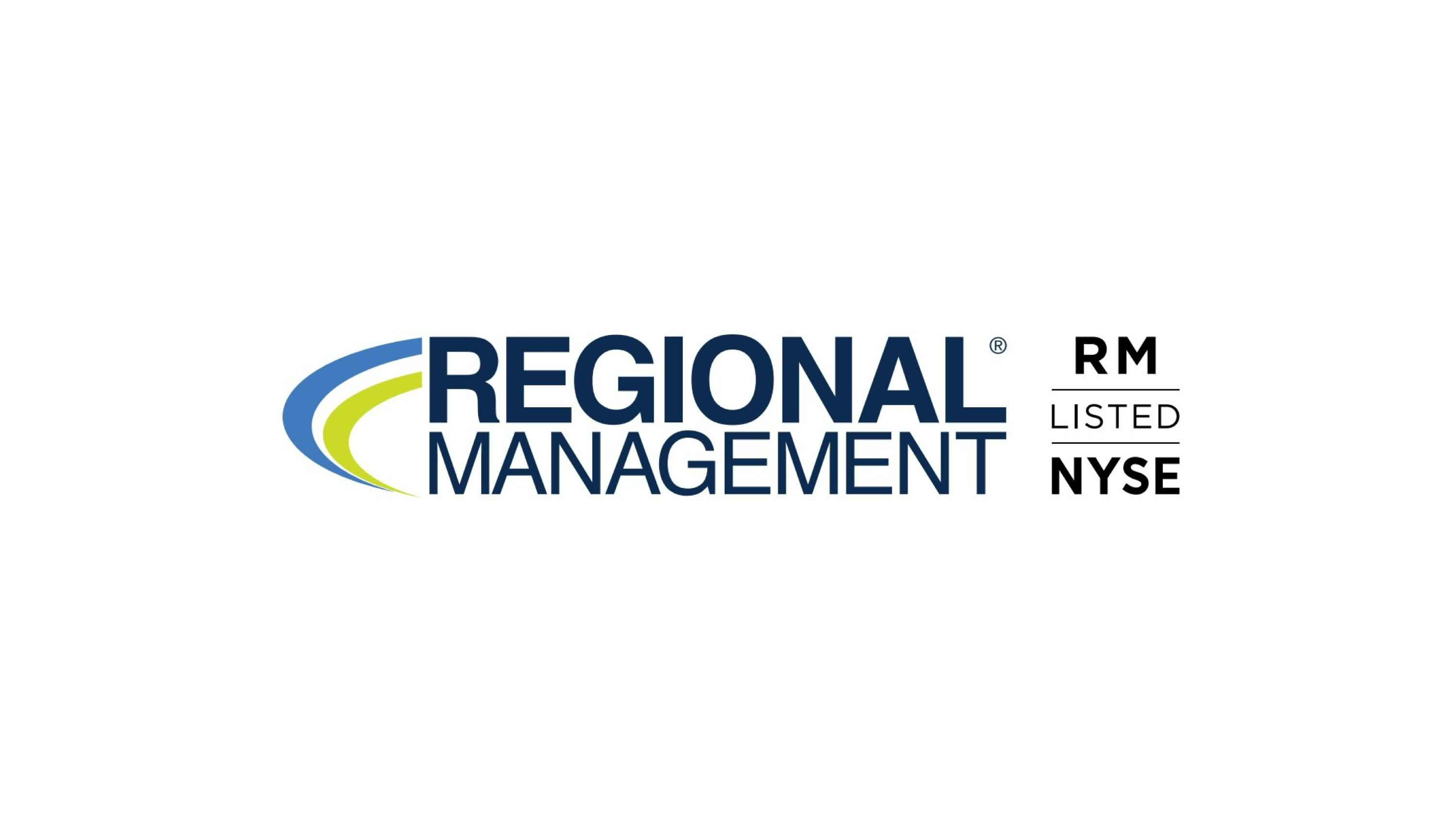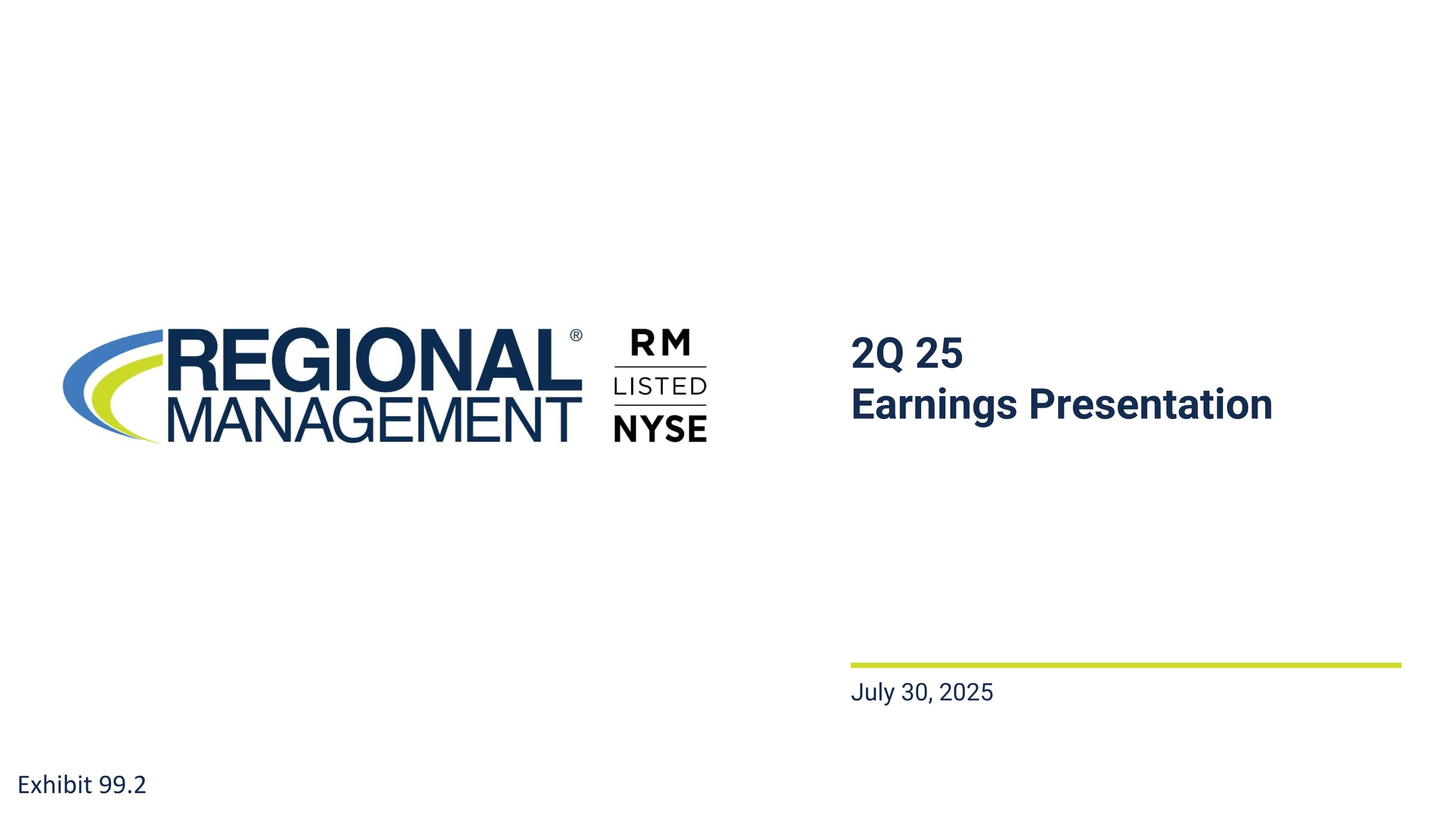

2Q 25 Earnings Presentation July 30, 2025 Exhibit 99.2

Legal Disclosures This document contains summarized information concerning Regional Management Corp. (the “Company”) and the Company’s business, operations, financial performance, and trends. No representation is made that the information in this document is complete. For additional financial, statistical, and business information, please see the Company’s most recent Annual Report on Form 10-K and Quarterly Reports on Form 10-Q filed with the U.S. Securities and Exchange Commission (the “SEC”), as well as the Company’s other reports filed with the SEC from time to time. Such reports are or will be available on the Company’s website (www.regionalmanagement.com) and on the SEC’s website (www.sec.gov). The information and opinions contained in this document are provided as of the date of this presentation and are subject to change without notice. This document has not been approved by any regulatory or supervisory authority. This presentation, the related remarks, and the responses to various questions may contain various “forward-looking statements” within the meaning of the Private Securities Litigation Reform Act of 1995. Forward-looking statements are not statements of historical fact but instead represent the Company’s expectations or beliefs concerning future events. Forward-looking statements include, without limitation, statements concerning financial outlook or future plans, objectives, goals, projections, strategies, events, or performance, and underlying assumptions and other statements related thereto. Words such as “may,” “will,” “should,” “likely,” “anticipates,” “expects,” “intends,” “plans,” “projects,” “believes,” “estimates,” “outlook,” and similar expressions may be used to identify these forward-looking statements. Such forward-looking statements speak only as of the date on which they were made and are about matters that are inherently subject to risks and uncertainties, many of which are outside of the control of the Company. As a result, actual performance and results may differ materially from those contemplated by these forward-looking statements. Therefore, investors should not place undue reliance on such statements. Factors that could cause actual results or performance to differ from the expectations expressed or implied in forward-looking statements include, but are not limited to, the following: managing growth effectively, implementing Regional Management's growth strategy, and opening new branches as planned; Regional Management's convenience check strategy; Regional Management's policies and procedures for underwriting, processing, and servicing loans; Regional Management's ability to collect on its loan portfolio; Regional Management's insurance operations; exposure to credit risk and repayment risk, which risks may increase in light of adverse or recessionary economic conditions; the implementation of evolving underwriting models and processes, including as to the effectiveness of Regional Management’s custom scorecards; changes in the competitive environment in which Regional Management operates or a decrease in the demand for its products; the geographic concentration of Regional Management's loan portfolio; the failure of third-party service providers, including those providing information technology products; changes in economic conditions in the markets Regional Management serves, including levels of unemployment and bankruptcies; the ability to achieve successful acquisitions and strategic alliances; the ability to make technological improvements as quickly as competitors; security breaches, cyber-attacks, failures in information systems, or fraudulent activity; the ability to originate loans; reliance on information technology resources and providers, including the risk of prolonged system outages; changes in current revenue and expense trends, including trends affecting delinquencies and credit losses; any future public health crises, including the impact of such crisis on our operations and financial condition; changes in operating and administrative expenses; the departure, transition, or replacement of key personnel; the ability to timely and effectively implement, transition to, and maintain the necessary information technology systems, infrastructure, processes, and controls to support Regional Management's operations and initiatives; changes in interest rates; existing sources of liquidity may become insufficient or access to these sources may become unexpectedly restricted; exposure to financial risk due to asset-backed securitization transactions; risks related to regulation and legal proceedings, including changes in laws or regulations or in the interpretation or enforcement of laws or regulations; changes in accounting standards, rules, and interpretations and the failure of related assumptions and estimates; the impact of changes in tax laws and guidance, including the timing and amount of revenues that may be recognized; risks related to the ownership of Regional Management's common stock, including volatility in the market price of shares of Regional Management's common stock; the timing and amount of future cash dividend payments; and anti-takeover provisions in Regional Management's charter documents and applicable state law. The foregoing factors and others are discussed in greater detail in the Company's filings with the SEC. The Company will not update or revise forward-looking statements to reflect events or circumstances after the date of this presentation or to reflect the occurrence of unanticipated events or the non-occurrence of anticipated events, whether as a result of new information, future developments, or otherwise, except as required by law. This presentation contains certain non-GAAP measures. Please refer to the Appendix accompanying this presentation for a reconciliation of non-GAAP measures to the most comparable GAAP measures. This presentation also contains certain financial terms and abbreviations. Please refer to the Appendix accompanying this presentation for a glossary of terms and abbreviations. 2
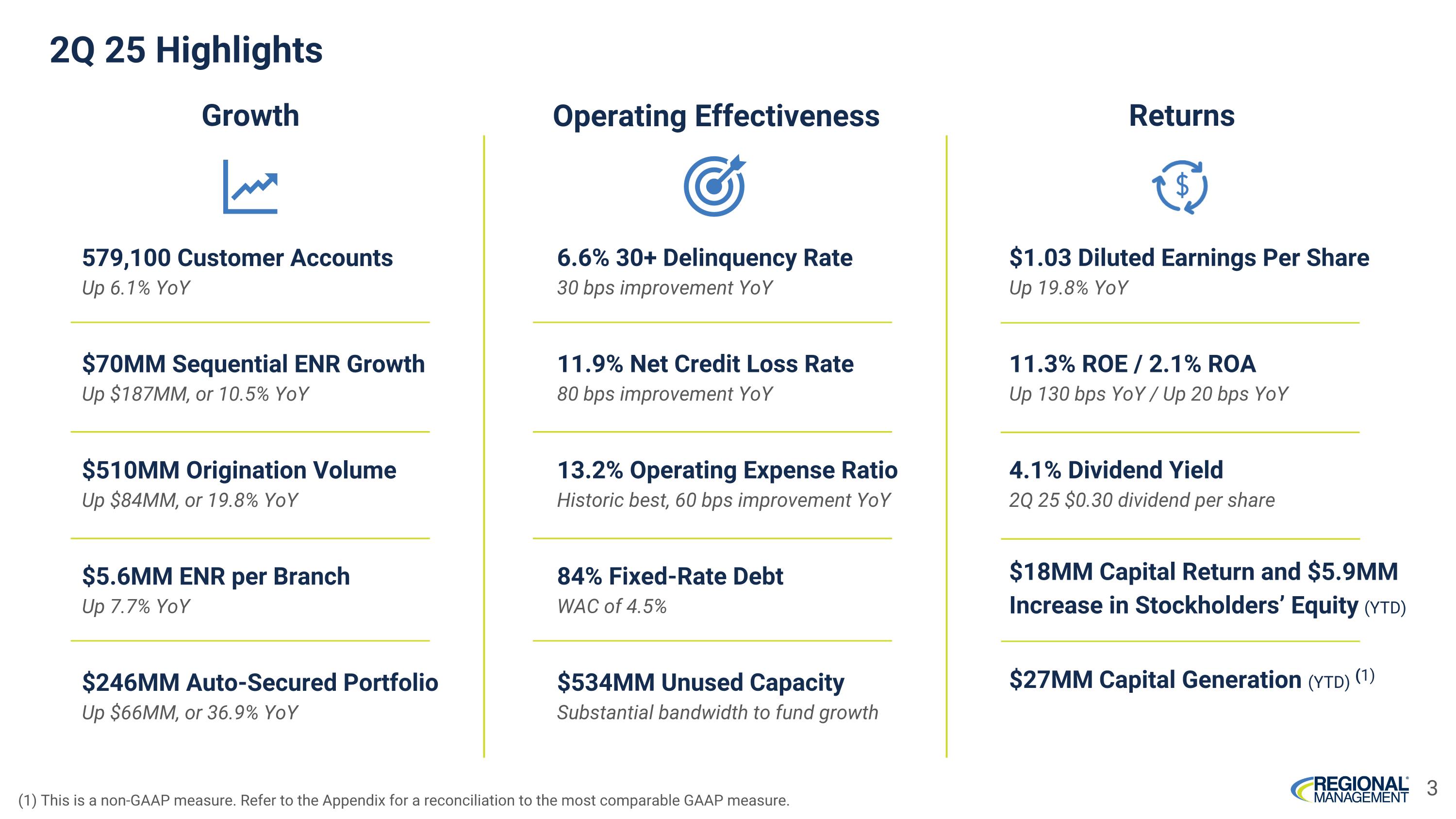
2Q 25 Highlights 579,100 Customer Accounts Up 6.1% YoY $70MM Sequential ENR Growth Up $187MM, or 10.5% YoY $510MM Origination Volume Up $84MM, or 19.8% YoY $5.6MM ENR per Branch Up 7.7% YoY $246MM Auto-Secured Portfolio Up $66MM, or 36.9% YoY 3 Growth Operating Effectiveness Returns 6.6% 30+ Delinquency Rate 30 bps improvement YoY 11.9% Net Credit Loss Rate 80 bps improvement YoY 13.2% Operating Expense Ratio Historic best, 60 bps improvement YoY 84% Fixed-Rate Debt WAC of 4.5% $534MM Unused Capacity Substantial bandwidth to fund growth $1.03 Diluted Earnings Per Share Up 19.8% YoY 11.3% ROE / 2.1% ROA Up 130 bps YoY / Up 20 bps YoY 4.1% Dividend Yield 2Q 25 $0.30 dividend per share $18MM Capital Return and $5.9MM Increase in Stockholders’ Equity (YTD) $27MM Capital Generation (YTD) (1) (1) This is a non-GAAP measure. Refer to the Appendix for a reconciliation to the most comparable GAAP measure.
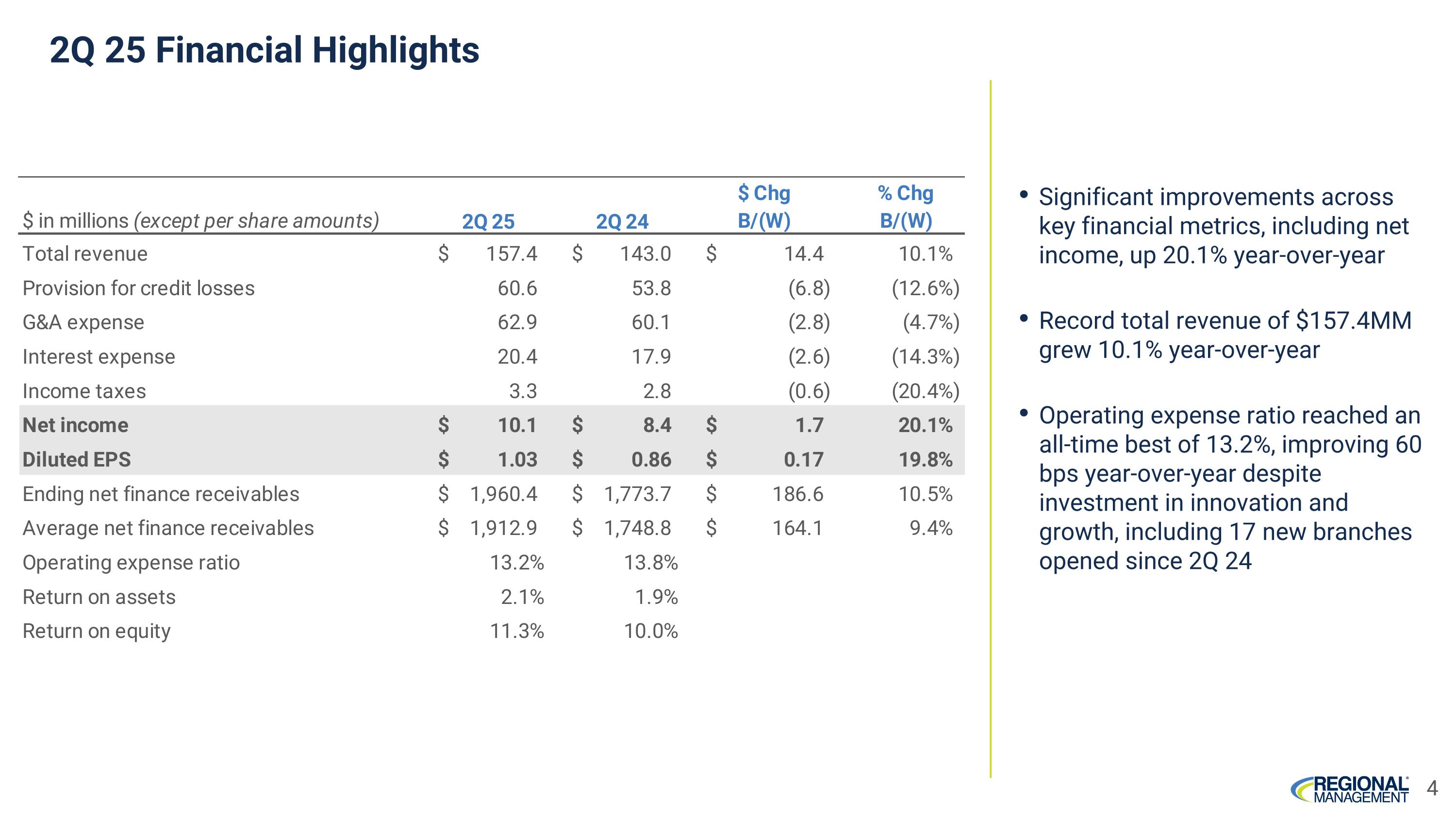
2Q 25 Financial Highlights Significant improvements across key financial metrics, including net income, up 20.1% year-over-year Record total revenue of $157.4MM grew 10.1% year-over-year Operating expense ratio reached an all-time best of 13.2%, improving 60 bps year-over-year despite investment in innovation and growth, including 17 new branches opened since 2Q 24 4
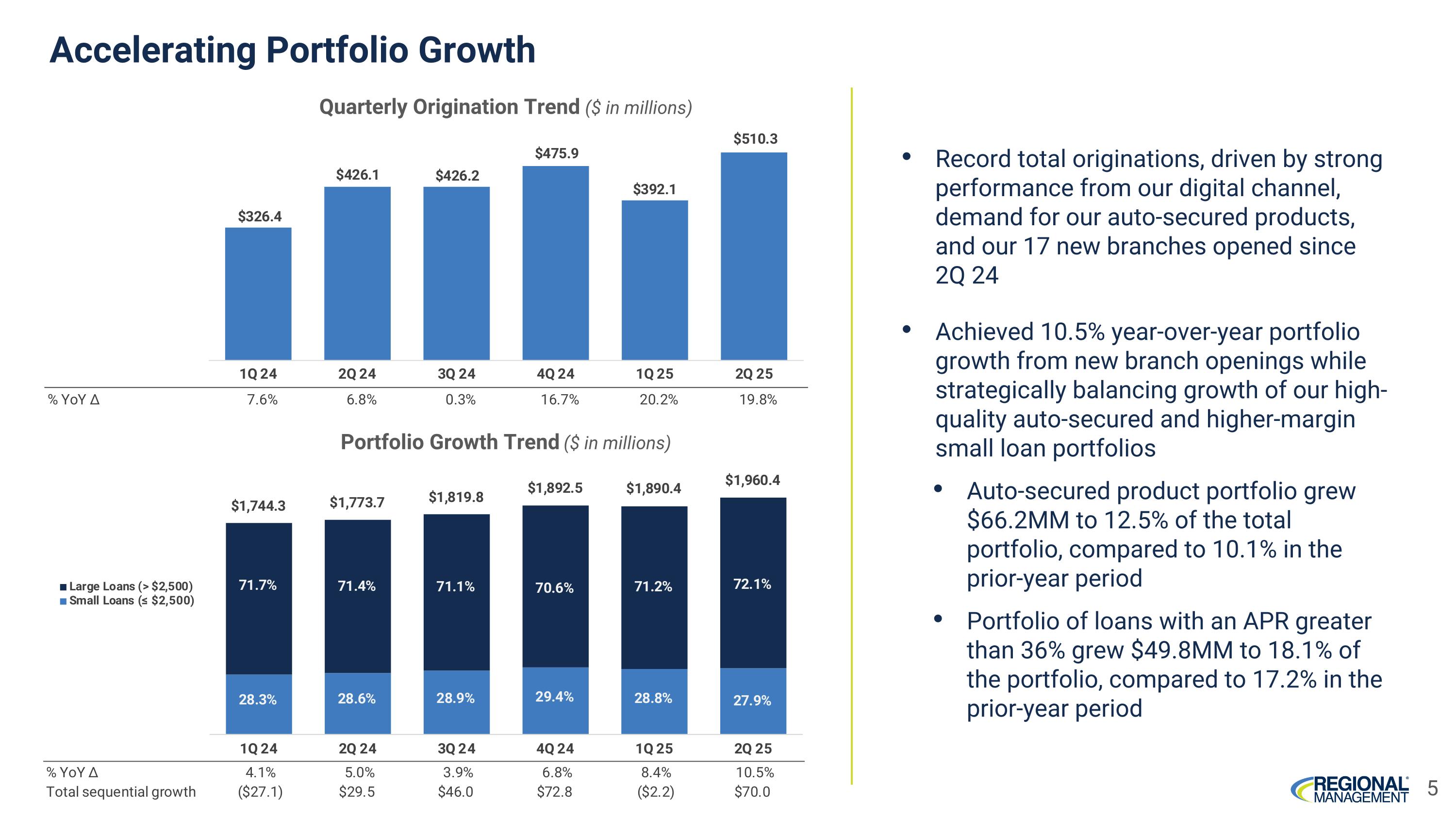
Portfolio Growth Trend ($ in millions) Accelerating Portfolio Growth 5 Record total originations, driven by strong performance from our digital channel, demand for our auto-secured products, and our 17 new branches opened since 2Q 24 Achieved 10.5% year-over-year portfolio growth from new branch openings while strategically balancing growth of our high-quality auto-secured and higher-margin small loan portfolios Auto-secured product portfolio grew $66.2MM to 12.5% of the total portfolio, compared to 10.1% in the prior-year period Portfolio of loans with an APR greater than 36% grew $49.8MM to 18.1% of the portfolio, compared to 17.2% in the prior-year period Quarterly Origination Trend ($ in millions)
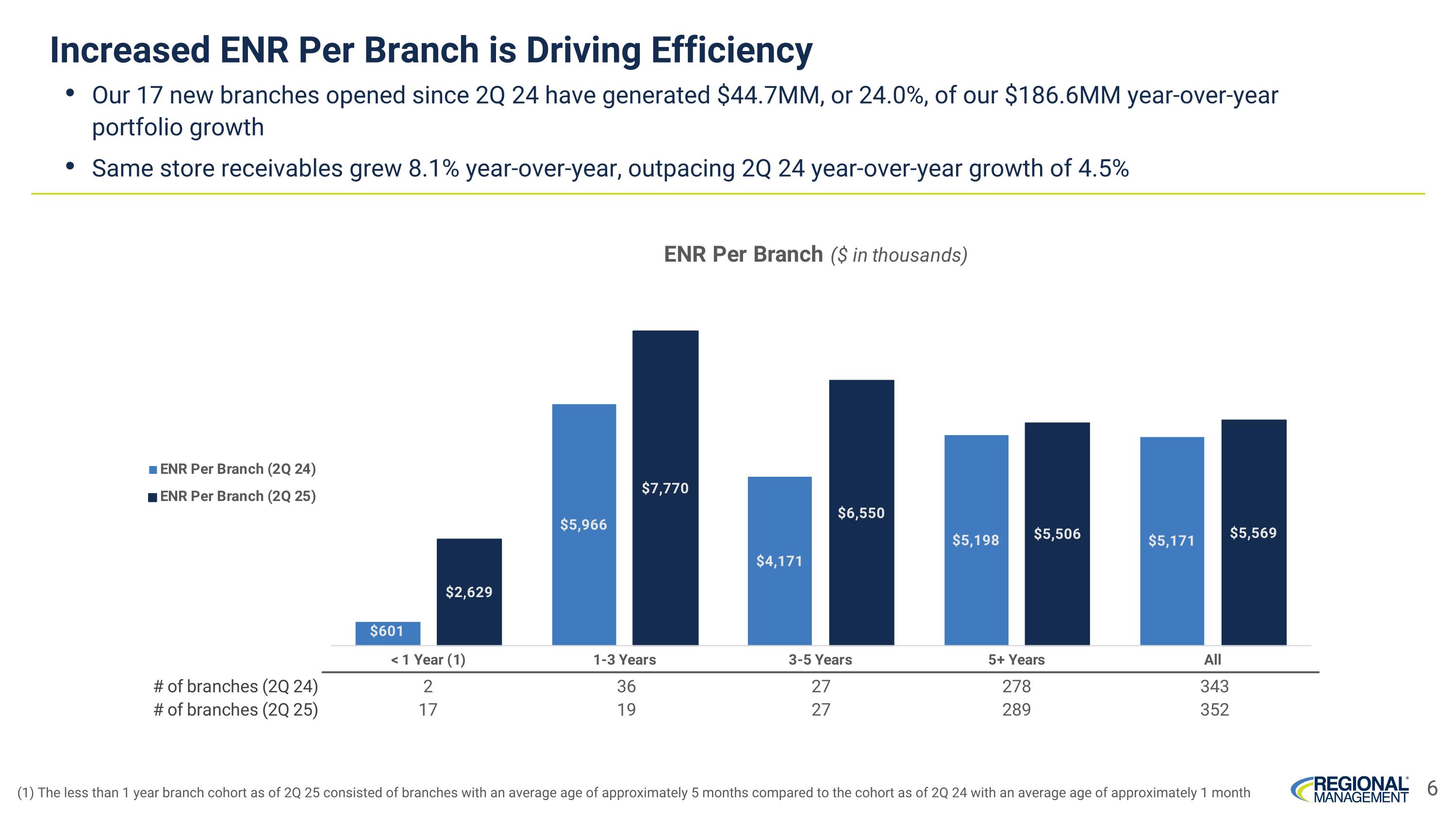
Increased ENR Per Branch is Driving Efficiency Our 17 new branches opened since 2Q 24 have generated $44.7MM, or 24.0%, of our $186.6MM year-over-year portfolio growth Same store receivables grew 8.1% year-over-year, outpacing 2Q 24 year-over-year growth of 4.5% 6 (1) The less than 1 year branch cohort as of 2Q 25 consisted of branches with an average age of approximately 5 months compared to the cohort as of 2Q 24 with an average age of approximately 1 month
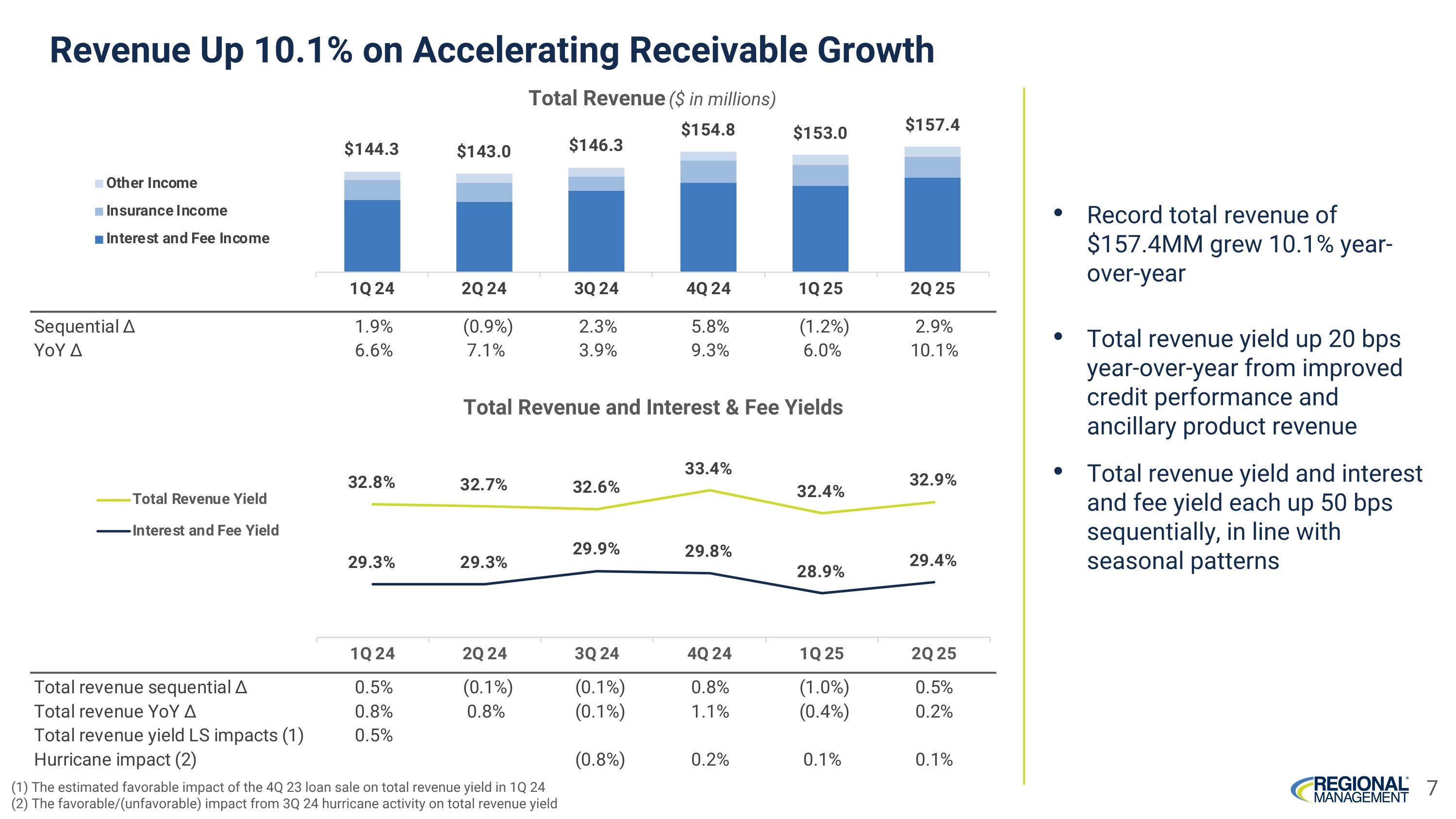
Record total revenue of $157.4MM grew 10.1% year-over-year Total revenue yield up 20 bps year-over-year from improved credit performance and ancillary product revenue Total revenue yield and interest and fee yield each up 50 bps sequentially, in line with seasonal patterns 7 Revenue Up 10.1% on Accelerating Receivable Growth Total Revenue and Interest & Fee Yields Total Revenue ($ in millions) (1) The estimated favorable impact of the 4Q 23 loan sale on total revenue yield in 1Q 24 (2) The favorable/(unfavorable) impact from 3Q 24 hurricane activity on total revenue yield

Credit Improvement Year-Over-Year Delinquency rate improved 50 bps sequentially and 30 bps year-over-year 30+ days past due of $129.4MM compares favorably to the allowance for credit losses of $202.8MM as of 2Q 25 Net credit loss rate improved 80 bps year-over-year from credit tightening and effective portfolio management Our net credit loss rate included a 40 bps impact from losses related to prior-year hurricane activity 30+ & 90+ Delinquency Rates ($ in millions) Net Credit Loss Rates 8 (1) The estimated favorable impact of the 4Q 23 loan sale on net credit loss rates in 1Q 24 (2) The favorable impact on the net credit loss rate in 4Q 24 from 3Q 24 hurricane activity, and the unfavorable impact to 2Q 25
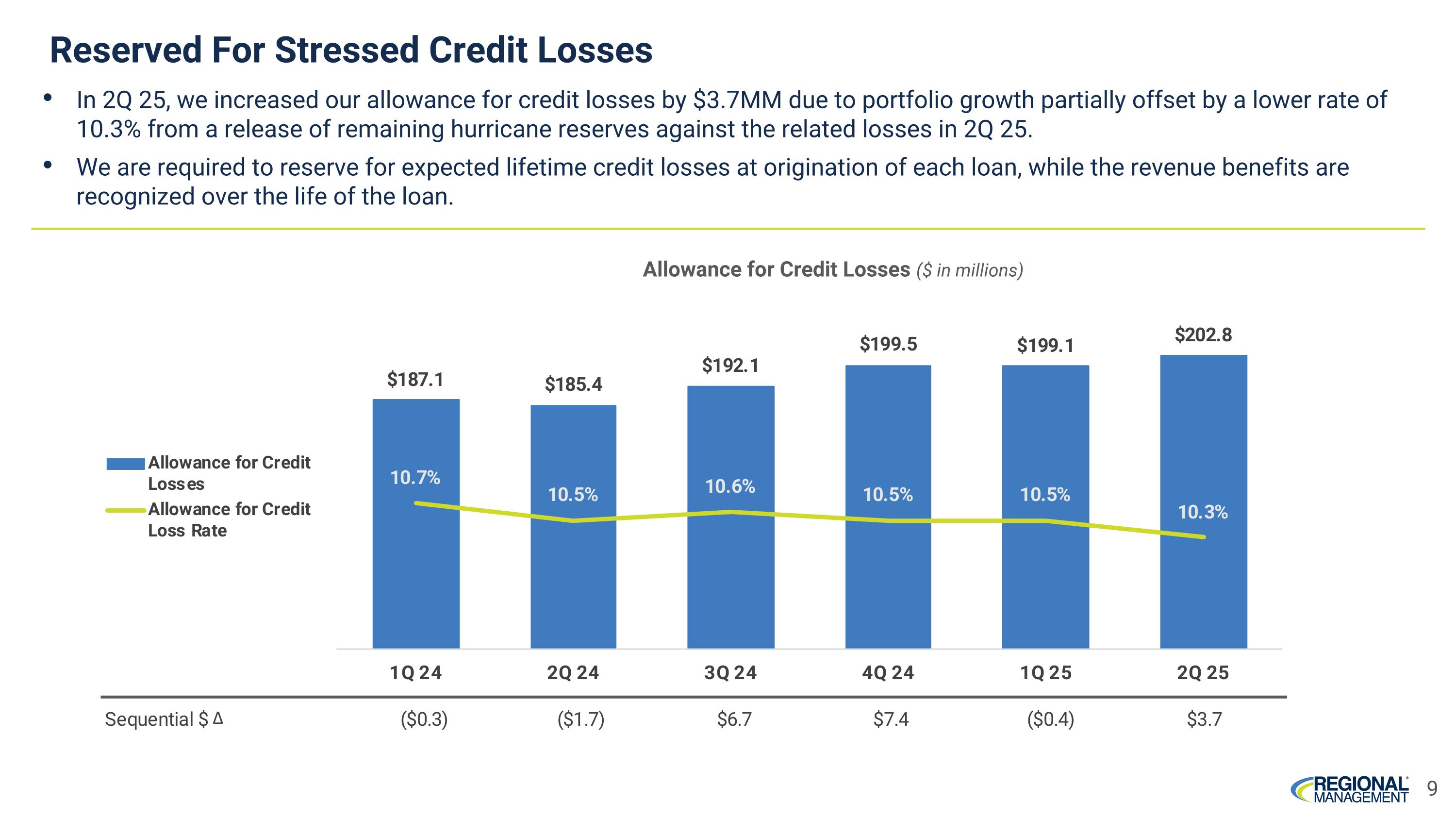
Reserved For Stressed Credit Losses In 2Q 25, we increased our allowance for credit losses by $3.7MM due to portfolio growth partially offset by a lower rate of 10.3% from a release of remaining hurricane reserves against the related losses in 2Q 25. We are required to reserve for expected lifetime credit losses at origination of each loan, while the revenue benefits are recognized over the life of the loan. Allowance for Credit Losses ($ in millions) 9
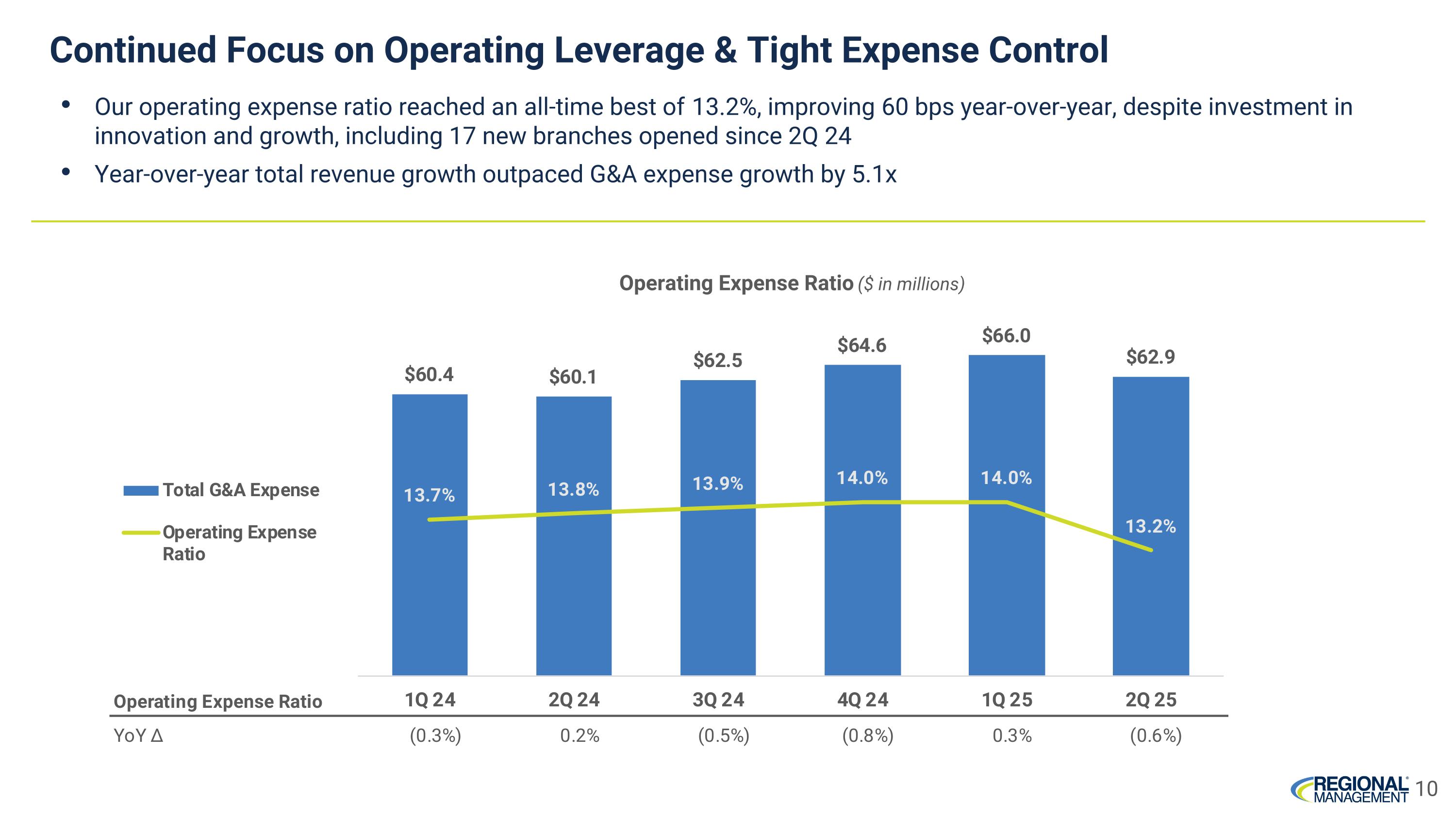
Continued Focus on Operating Leverage & Tight Expense Control 10 Operating Expense Ratio ($ in millions) Our operating expense ratio reached an all-time best of 13.2%, improving 60 bps year-over-year, despite investment in innovation and growth, including 17 new branches opened since 2Q 24 Year-over-year total revenue growth outpaced G&A expense growth by 5.1x
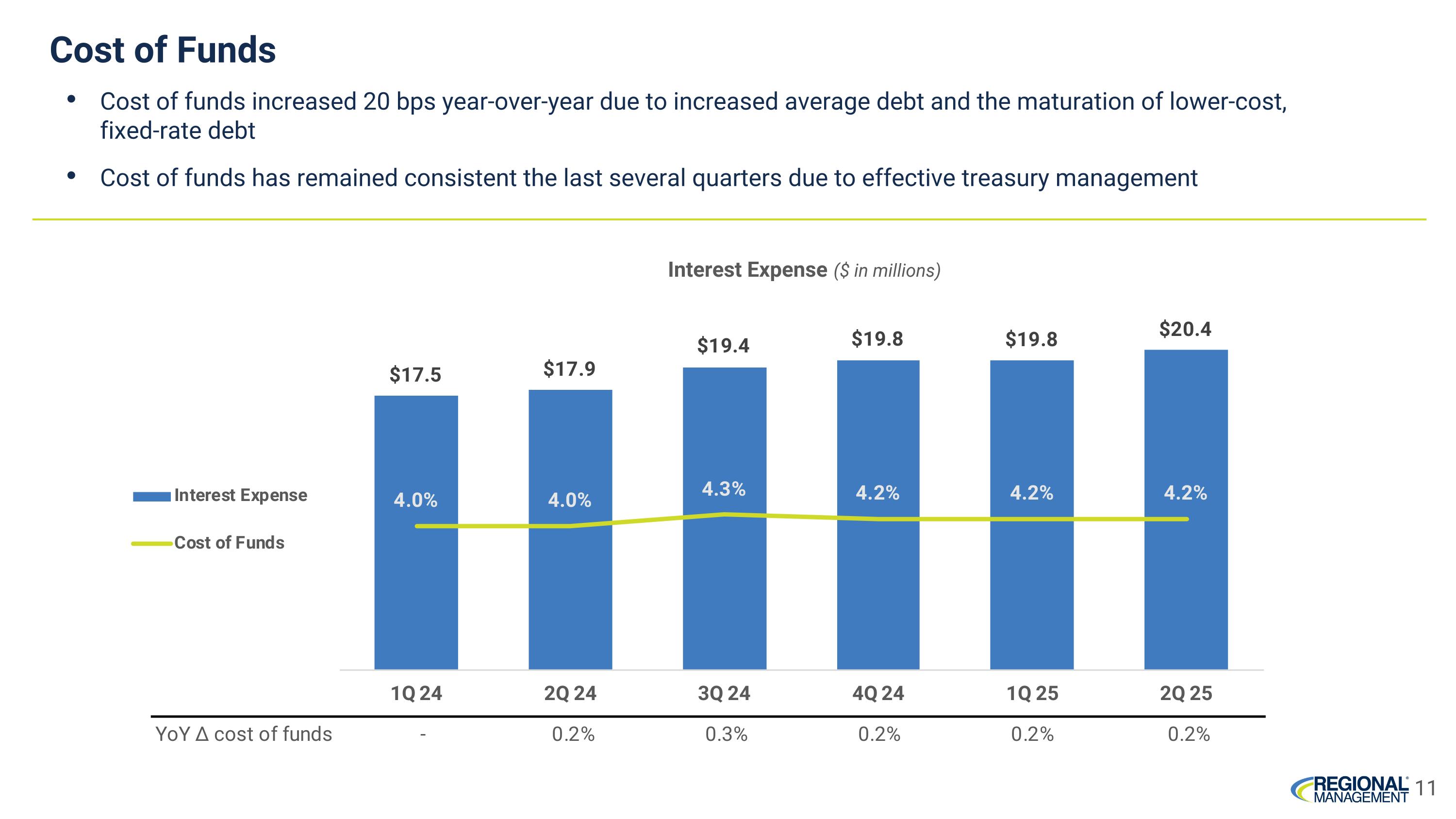
Cost of funds increased 20 bps year-over-year due to increased average debt and the maturation of lower-cost, fixed-rate debt Cost of funds has remained consistent the last several quarters due to effective treasury management Cost of Funds 11 Interest Expense ($ in millions)
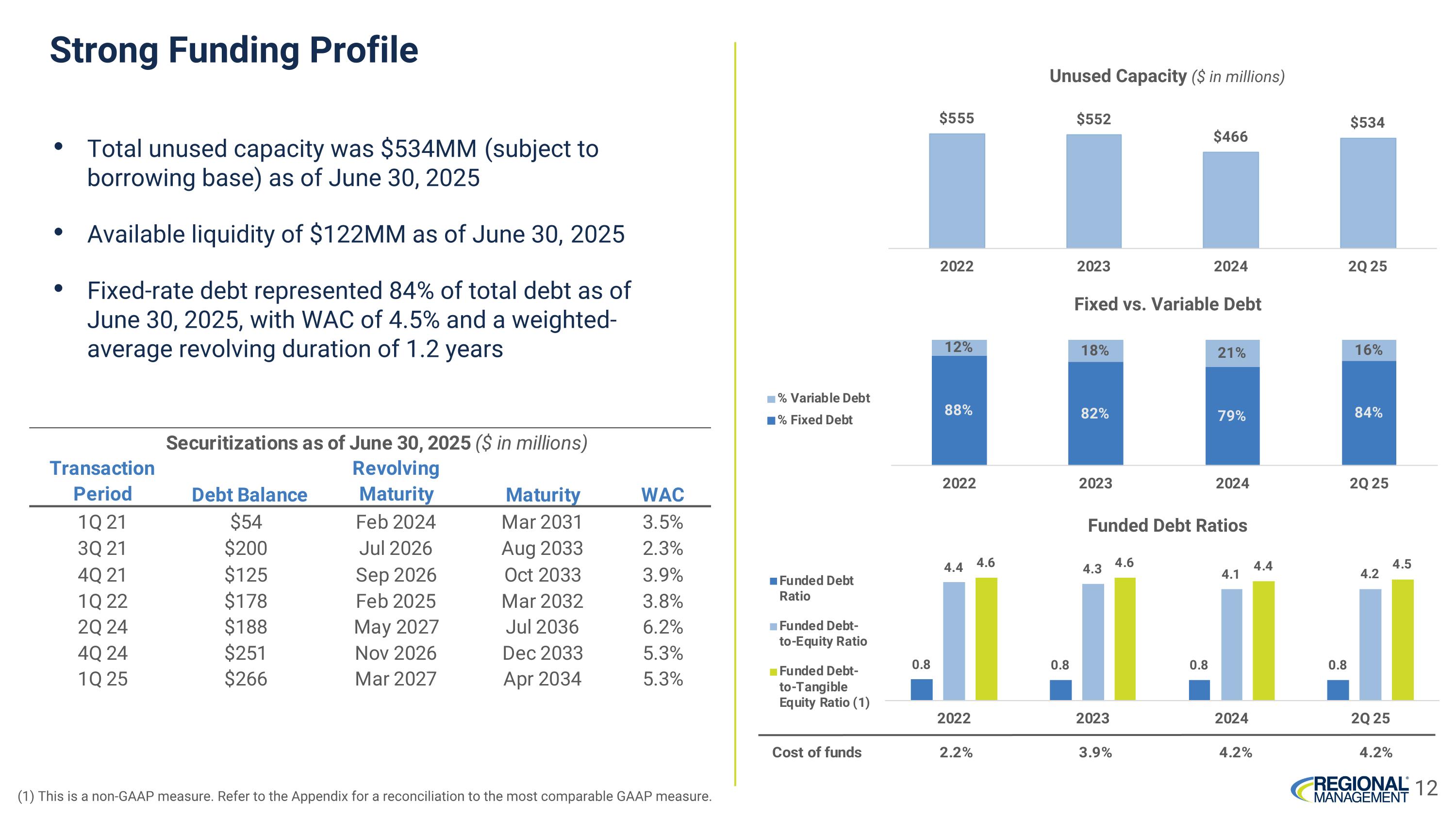
Total unused capacity was $534MM (subject to borrowing base) as of June 30, 2025 Available liquidity of $122MM as of June 30, 2025 Fixed-rate debt represented 84% of total debt as of June 30, 2025, with WAC of 4.5% and a weighted-average revolving duration of 1.2 years Strong Funding Profile Unused Capacity ($ in millions) Fixed vs. Variable Debt Funded Debt Ratios 12 (1) This is a non-GAAP measure. Refer to the Appendix for a reconciliation to the most comparable GAAP measure.

Excess Capital Consistently Returned to Stockholders Capital Performance Since 2020 $187MM total capital increase $170MM returned to stockholders $356MM capital generated 12.8% CAGR 21% ratio of capital generation to average stockholders’ equity Proven track record of excess capital generation allowing returns to stockholders and reinvesting in strategic initiatives to generate sustainable, long-term profitable growth Significant capital generated even during recent periods of high inflation 13 (1) This is a non-GAAP measure. Refer to the Appendix for a reconciliation to the most comparable GAAP measure. (2) YTD 25 is annualized.
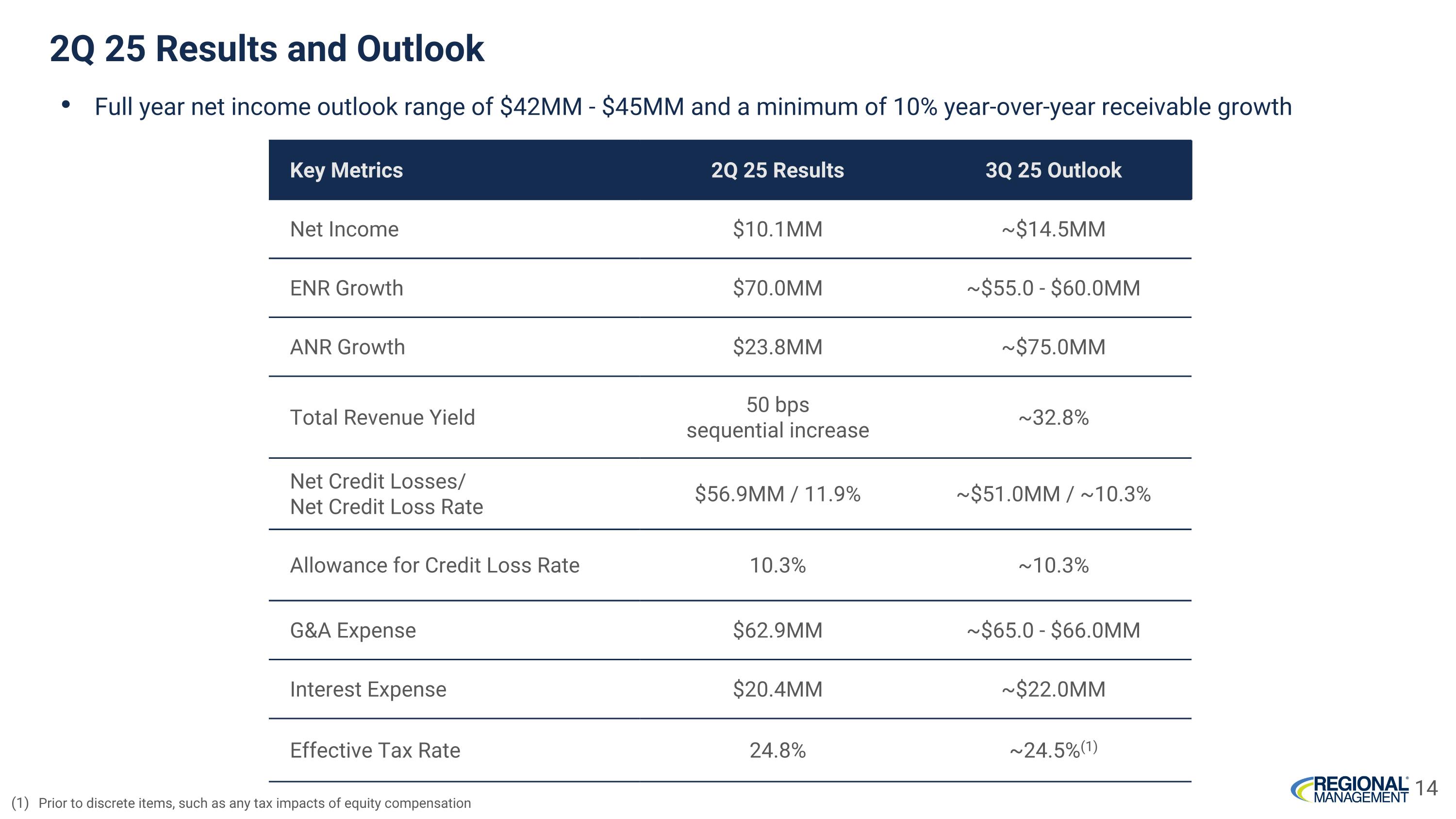
2Q 25 Results and Outlook 14 Prior to discrete items, such as any tax impacts of equity compensation Key Metrics 2Q 25 Results 3Q 25 Outlook Net Income $10.1MM ~$14.5MM ENR Growth $70.0MM ~$55.0 - $60.0MM ANR Growth $23.8MM ~$75.0MM Total Revenue Yield 50 bps sequential increase ~32.8% Net Credit Losses/ Net Credit Loss Rate $56.9MM / 11.9% ~$51.0MM / ~10.3% Allowance for Credit Loss Rate 10.3% ~10.3% G&A Expense $62.9MM ~$65.0 - $66.0MM Interest Expense $20.4MM ~$22.0MM Effective Tax Rate 24.8% ~24.5%(1) Full year net income outlook range of $42MM - $45MM and a minimum of 10% year-over-year receivable growth

Appendix 15

Record high digital volume driven by seasonal demand and geographic expansion Digital volume represented 32.2% of our total new borrower volume Large loans represented 76.3% of new borrower digitally sourced loans booked in 2Q 25 Digitally Sourced Origination Volume ($ in millions) Digitally Sourced Originations – Record High 16

Diversified Liquidity Profile Long history of liquidity support from a strong group of banking partners Diversified funding platform with a senior revolving facility, warehouse facilities, and securitizations 17
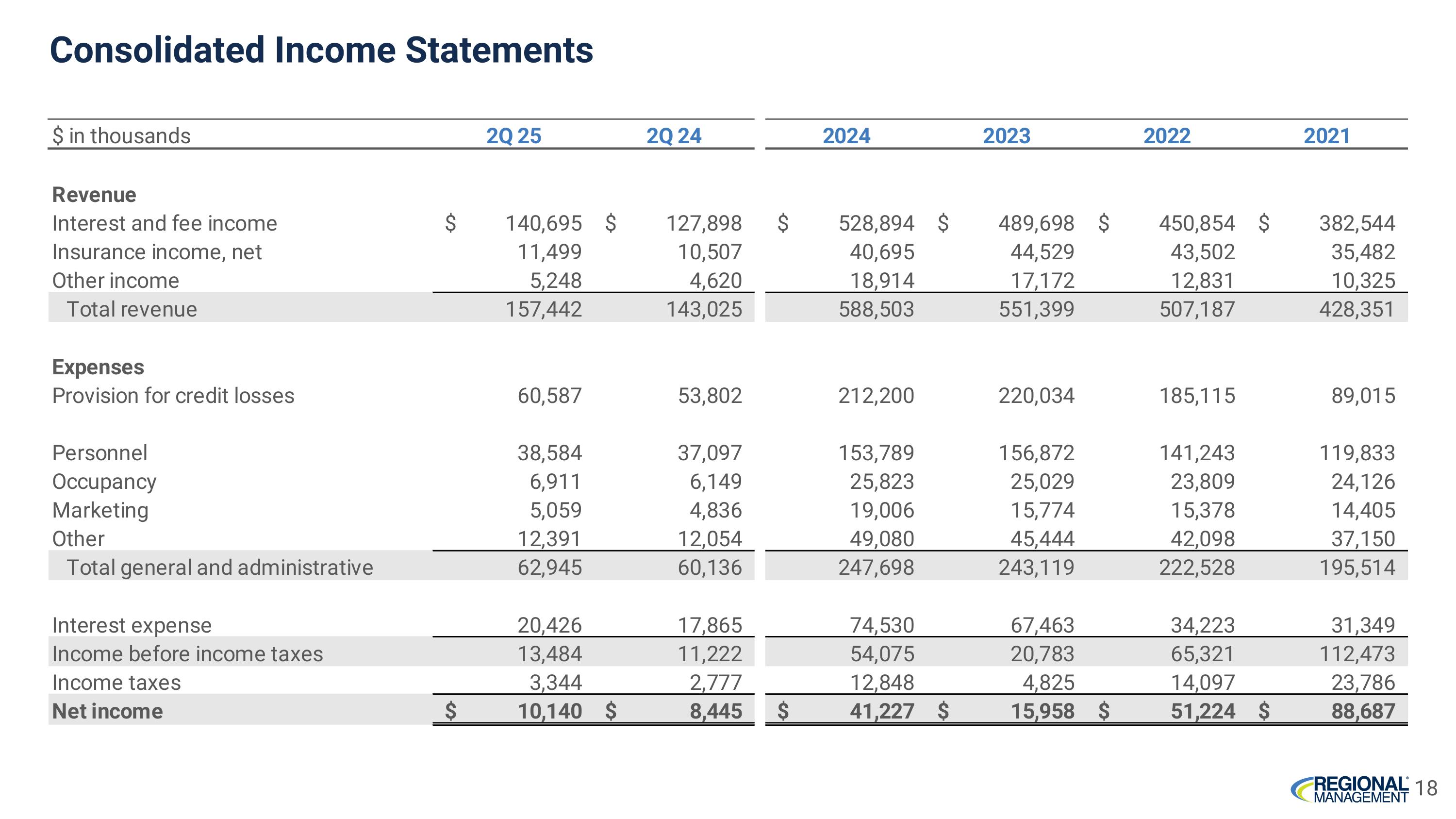
Consolidated Income Statements 18
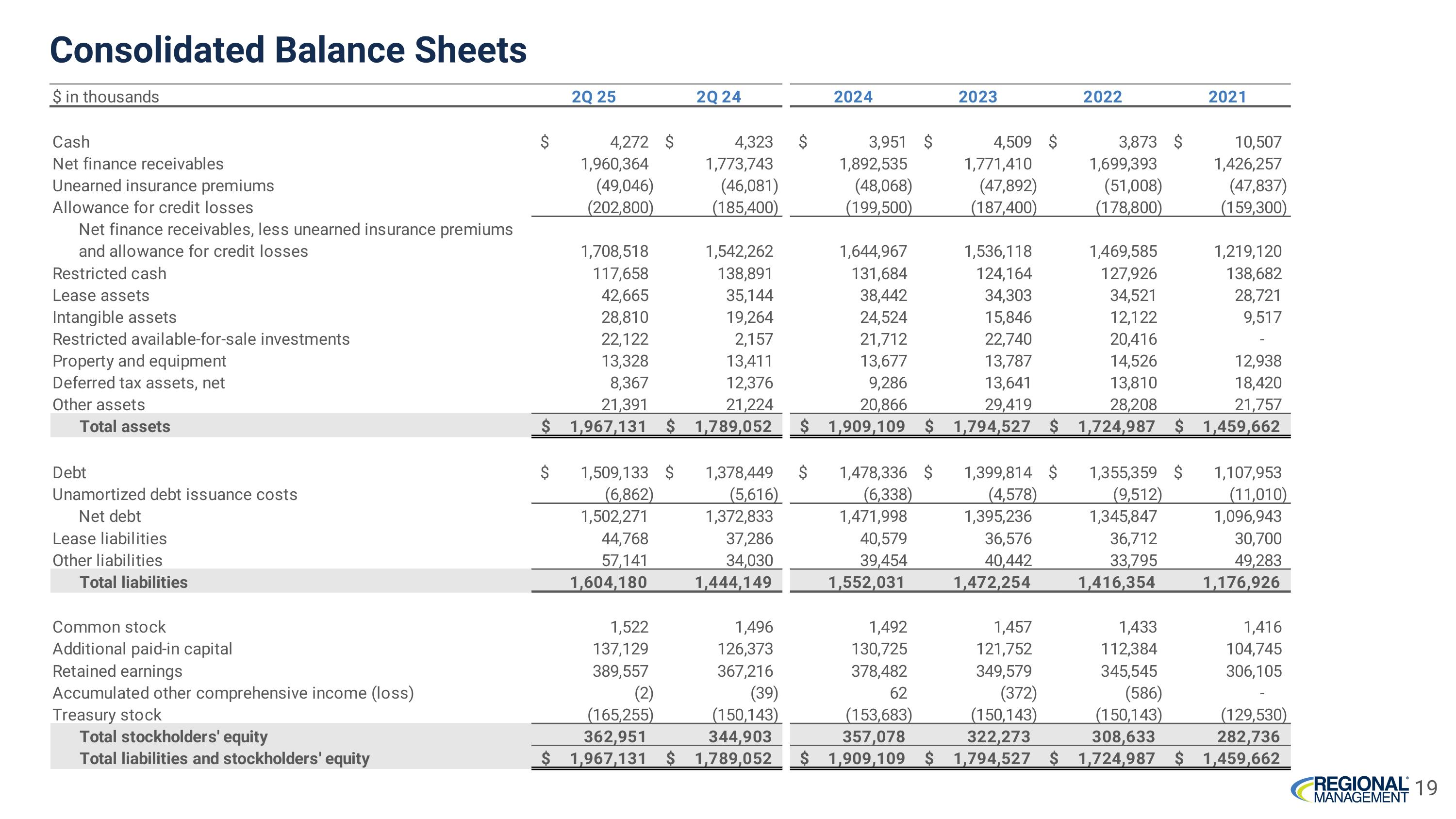
Consolidated Balance Sheets 19

Non-GAAP Financial Measures In addition to financial measures presented in accordance with generally accepted accounting principles (“GAAP”), this presentation contains certain non-GAAP financial measures. The Company’s management utilizes non-GAAP measures as additional metrics to aid in, and enhance, its understanding of the Company’s financial results. The Company believes that these non-GAAP measures provide useful information by excluding certain material items that may not be indicative of our operating results. As a result, the Company believes that the non-GAAP measures that it has presented will aid in the evaluation of the operating performance of the business. Total capital and capital return, capital generation, and capital generation as a % of average stockholders' equity are non-GAAP measures to include stock repurchases and dividends returned to stockholders with total capital. Management uses these measures to evaluate the Company's ability to generate capital to return to stockholders, reinvest in strategic initiatives, and evaluate its capacity to absorb losses. The Company also believes that these capital and absorption measures provide useful information to users of the Company’s financial statements in the evaluation of its ability to generate capital to return to stockholders, reinvest in strategic initiatives, and evaluate its capacity to absorb losses. Furthermore, tangible equity, tangible book value per share, and the funded debt-to-tangible equity ratio are non-GAAP measures that adjust GAAP measures to exclude intangible assets. Management uses these equity measures to evaluate and manage the Company’s capital and leverage position. The Company also believes that these equity measures are commonly used in the financial services industry and provide useful information to users of the Company’s financial statements in the evaluation of its capital and leverage position. As a result, the Company also believes that these adjusted measures will aid users of its financial statements in the evaluation of its operating performance. This non-GAAP financial information should be considered in addition to, not as a substitute for or superior to, measures of financial performance prepared in accordance with GAAP. In addition, the Company’s non-GAAP measures may not be comparable to similarly titled non-GAAP measures of other companies. The following tables provide reconciliations of GAAP measures to non-GAAP measures. 20

Non-GAAP Financial Measures (Cont’d) 21

Non-GAAP Financial Measures (Cont’d) 22

Glossary 23 Allowance for credit loss rate – allowance for credit losses as a percentage of ending net finance receivables ANR – average net finance receivables Bps – basis points Capital generation – the year-to-date change in total capital and capital return from the prior year-end Cost of funds – annualized interest expense as a percentage of average net finance receivables Cumulative capital return – dividend and common stock repurchase activity that has occurred since December 31, 2019 Debt balance – the balance for each respective debt agreement, composed of principal balance and accrued interest Dividend yield – annualized dividends per share divided by the closing share price as of the last day of the quarter Delinquency rate (DQ %) – delinquent loans outstanding as a percentage of ending net finance receivables ENR – ending net finance receivables Funded debt ratio – total debt divided by total assets Interest and fee yield – annualized interest and fee income as a percentage of average net finance receivables Net credit loss rate – annualized net credit losses as a percentage of average net finance receivables Operating expense ratio – annualized general and administrative expenses as a percentage of average net finance receivables Return on assets (ROA) – annualized net income as a percentage of average total assets Return on equity (ROE) – annualized net income as a percentage of average stockholders’ equity Same store – comparison of branches with a comparable branch base; the comparable branch base includes those branches open for at least 1 year Total capital – stockholders’ equity plus allowance for credit losses Total revenue yield – annualized total revenue as a percentage of average net finance receivables WAC – weighted-average coupon
